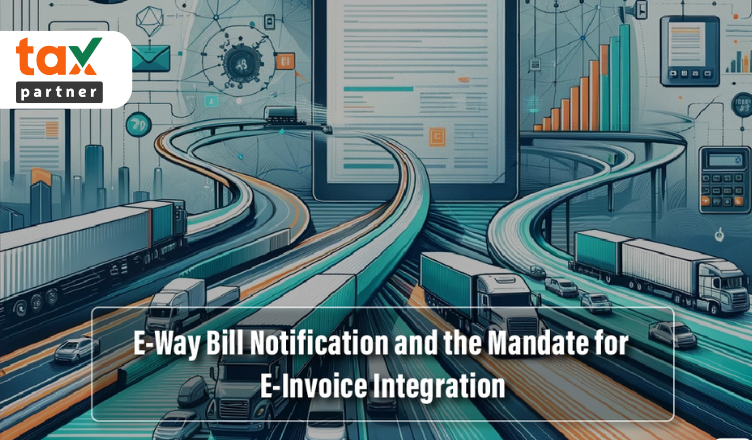Connect with us for all your queries



Author- Tanvi Thapliyal
The national informatics centre released an advisory dated 5th january 2024 issuing e-way bill rules which stated that the e-way bill generation of such businesses will be blocked who fails to include e-invoice details i.e. the IRN (invoice registration number). NIC vide notification dated 10th january 2024 withdrew the notification of 5th january but currently the official website shows only the notification released on 5th january citing dilemma about its status.
But sooner or later this mandate will be applicable hence, it is important for us to understand its applicability, effect on the businesses and why e-invoice and e-way bills are an important instrument for checks and balances.
National informatics centre in its notification dated 5-01-2024 released an advisory stating “blocking the generation of E-Way Bill without e-invoice/IRN details for B2B and B2E transactions for e-invoice enabled taxpayers. '' this decision was based on an analysis which found that some of the taxpayer who are eligible to generate e-invoicing are generating e-way bills for B2B and B2E transactions without linking their e-invoices.it was noticed that at times the invoice details when separately entered leads to confusion as they do not match with certain parameters of the e-way bill.
1st march 2024 is the deadline for these eligible B2B and B2E businesses to initiate procedural changes within their servers and equip themselves likewise because after the due date they will not be able to generate e-way bills without e- invoice.
On 10th january 2024, this notification was withdrawn and the information of the same was made available on the e-way bill portal.
Later after a few days the notification citing withdrawal is nowhere to be found in the portal and only the one citing 1st march as due date exists resulting in confusion.
It is important to note that as per the current information on the portal the regime will be made compulsory from 1st march 2023 onwards and measures in line should be initiated right away which is why it is important for us to understand its implications in detail.
E-invoice generation is a compulsion for businesses whose turnover exceeds INR 5 crores.
It is applicable upon and is mandatory for only certain category of businesses such as-
The notification nowhere applies to a
Even if the E-way Bill is generated by a transporter yet similar checks for e-invoice will be applicable.
No new portal or extension for the same will be generated by the government, changes are to be made by the taxpayers and the transporters in order to ensure their smooth functioning.
Supply
as used in the context of e-Way bills, mainly denotes the transfer, sale, barter, or exchange of products for the sake of trade or commerce.
When a consignment's value surpasses the specified threshold, an e-Way bill must be created for supply-related shipments. Both intrastate and interstate movements can be facilitated by this.
Exports
Goods transported from one nation to another are known as exports. Because of their effect on a country's trade balance, exports are subject to variable tax treatment under several regimes The e-Way bill is typically necessary for exports irrespective of the size of the shipment due to the significance of documenting items leaving the nation. The e-Way bill system is designed to accommodate exports that are under bond or have a Letter of Undertaking (LUT) that does not require tax payment.
Semi-Knocked Down, or SKD
The term "SKD shipment" refers to shipments of partially assembled goods that are not yet ready for final assembly. This is typical in sectors like transportation, where components are transported to a different site for final assembly.If the components are shipped separately, the shipment of SKD goods could need the creation of numerous e-Way bills. The details may vary according to the tax laws of the relevant jurisdiction.
CKD "Completely Knocked Down."
Critically Broken Down (CKD) items are those that are sent in pieces and will need to be put back together at the destination. Taking advantage of local manufacturing incentives or lowering import duties are common reasons for using this strategy.Like SKD, CKD movements may necessitate independent e-Way bills for various components in the event that they are dispatched at distinct intervals or necessitate comprehensive paperwork to guarantee adherence to tax laws.
lots
This class describes the transportation of items in smaller quantities, often in batches or lots. These commodities may be part of a bigger shipment, but they are transported independently.If a shipment of goods is being delivered in lots and each lot fits the requirements for e-Way bill generation, such as surpassing the value threshold, then an e-Way bill must be generated for each lot.
When it comes to technology integration, small and medium-sized businesses (SMEs) may have difficulty merging their existing systems with the revised e-Way bill site. This is especially true if they had previously relied on manual processes.
Additional Compliance will be a Burden
The increased compliance requirements might be burdensome, particularly for small and medium-sized enterprises (SMEs), as they would shift resources away from core company activities and towards regulatory compliance.
Need of making quick adjustments might disrupt the supply chain
Disruptions in the Supply Chain As firms adjust to the new regulations, there is a possibility that there may be temporary disruptions in the supply chain. These disruptions may include delays in shipment and extended transit times. These disruptions will have an impact on inventory management and may even result in stock outs or overstock problems.
Imposition of Penalties and Fines
Failure to comply with the new limits related to the e-Way bill could result in hefty penalties and fines, which would add a financial burden on top of the obstacles that are already going to commence due to this notification.
Businesses can overcome these challenges by implementing various strategies:
Utilise Technology
Invest in reliable logistics and compliance management software to automate and streamline the generation and management of e-Way bills.\
Get involved in advocacy
Get involved in industry associations and work with policymakers to push for fair implementation timelines and assistance for small and medium-sized enterprises.
Emphasise on Training
Develop thorough training programmes to make sure that employees in all relevant departments understand the new regulations.
Update Logistics Strategies
Review logistics and supply chain strategies to find cost-effective ways to adhere to the new restrictions without greatly affecting operational efficiency.
Work together with partners
Collaborate closely with logistics partners, suppliers, and customers to maintain alignment and reduce disruptions across the supply chain.
It's crucial for businesses to grasp the intricacies of this notification and provide training to their personnels of these e-Way bill requirements for various types of goods movement so as to maintain compliance and ensure smooth operations. Best is to seek advice from tax professionals or legal advisors who are knowledgeable about the regulations in your area they can help you navigate these requirements successfully.
1. What are the upcoming restrictions on e-Way bills effective from March 2024?
Starting March 2024, the latest e-Way bill restrictions bring in new requirements for generating e-Way bills for moving goods. There could be adjustments made to the value threshold for e-Way bill generation, more documentation needed, and increased compliance checks to improve transparency and minimise tax evasion.
2. How will the new restrictions affect businesses?
Businesses might face various effects, such as:
Enhanced Compliance: More stringent criteria and increased documentation needs may require more thorough record-keeping.
Operational Changes: Businesses may have to adjust logistics strategies, which could impact order sizes, transportation schedules, and supplier connections.
Cost Considerations: The rise in logistics and administrative costs may result from increased shipment frequency and greater compliance responsibilities.
3. What practical challenges could businesses encounter as a result of these changes?
When it comes to technology integration, smaller businesses might face challenges in aligning their systems with the latest e-Way bill portal.
The new requirements may shift focus and resources away from essential tasks towards meeting regulatory standards.
Dealing with supply chain disruptions can lead to temporary impacts on inventory management and order fulfilment due to adjustments to new regulations.
Businesses may face penalties and fines for not complying with the new restrictions.
4. How should businesses get ready for the upcoming e-Way bill restrictions?
Here are some preparation strategies:
Investing in technology involves upgrading the IT infrastructure to ensure seamless integration with the e-Way bill portal.
Training Staff: Leading training sessions to help employees understand the new requirements.
Revising Logistics Strategies involves evaluating and adjusting logistics and supply chain strategies to minimise costs and ensure compliance.
Working with logistics partners, suppliers, and customers to maintain alignment and reduce disruptions.
5. Are there any exemptions or special considerations that will be provided under the new restrictions?
Specific exemptions or special considerations may be provided for certain goods, industries, or scenarios based on their nature or value. It's important for businesses to stay updated on any exemptions that could benefit their operations in order to make the most of these provisions.
6. If businesses encounter challenges in meeting the new e-Way bill requirements, what steps should they take?
It's important to seek professional advice from tax professionals or legal advisors to fully grasp the requirements and effectively navigate any challenges.Connect with Industry Associations: Engage in forums or associations that offer support and advocacy for businesses dealing with similar challenges.Utilise government resources to your advantage: Make sure to take advantage of the guidance and resources offered by tax authorities such as workshops, helplines, and online portals to address any questions and get the help you need.
7. How will the new e-Way bill restrictions impact the transportation of goods across state borders and within the same state?
The new rules will impact both interstate and intrastate transportation, possibly prompting businesses to modify their approaches for each category of movement. Handling various state-specific regulations and ensuring interstate consignments comply with the updated national framework may be necessary.
8. It is essential for businesses to grasp and get ready for the impacts of the new e-Way bill restrictions?
In order to successfully overcome the upcoming challenges and ensure seamless operations. It is crucial to stay informed, plan proactively, and make strategic adjustments to maintain compliance and reduce disruptions.
Tax Partner is India’s most reliable online business service platform, dedicated to helping you in starting, growing, & flourishing your business with our wide array of expert services at a very affordable cost.